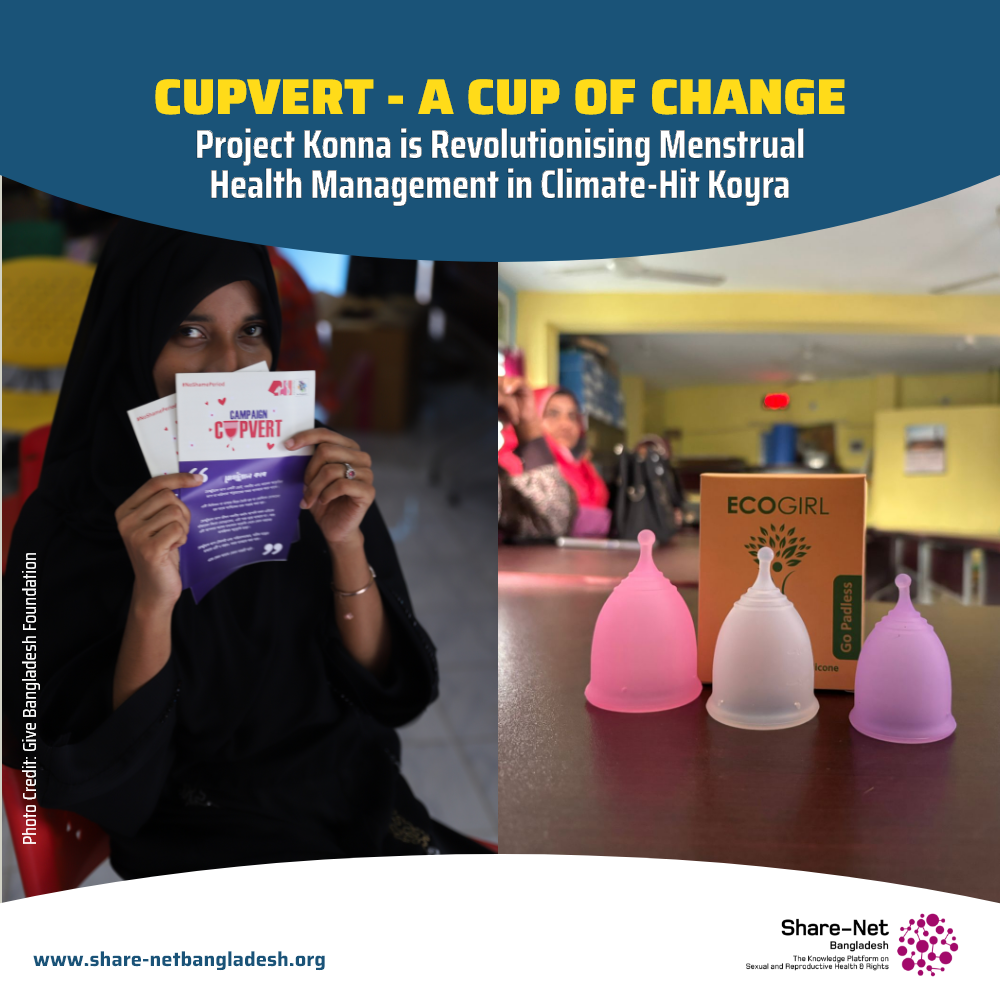Cupvert – A Cup of Change: Project Konna is Revolutionising Menstrual Health Management in Climate-Hit Koyra
In Koyra, a coastal upazila battered by rising seas and cyclones, resilience is not just about rebuilding homes or protecting crops. It’s also about something deeply personal, and often hidden: how women and girls manage their periods.
For decades, menstrual health has remained a silent struggle in climate-hit Koyra. Salty water, broken sanitation systems, and poverty have forced women to depend on old cloths—washed again and again in contaminated water. A 2019 study revealed that over 72% of menstruating women here rely on reused cloth. The result? A surge in infections, complications, and even hysterectomies. For many, pads are a luxury. Some have even resorted to hormonal contraceptives just to avoid bleeding altogether.
That is why the Cupvert campaign, launched in January 2025 under Give Bangladesh Foundation’s Project Konna, feels nothing short of revolutionary. It introduced menstrual cups—a simple, reusable, medical-grade silicone cup—to women who had never heard of such an option. And what seemed strange, even laughable at first, is now becoming a symbol of dignity, health, and hope.
Why a Cup Matters in Climate-Hit Koyra
At first glance, a menstrual cup might seem like just another product. But in Koyra, it’s much more. It is:
-
Sustainable: One cup lasts up to 10 years, reducing reliance on costly pads and cutting waste.
-
Water-efficient: Unlike cloth that needs scrubbing with liters of unsafe water, a cup can be rinsed with just a few mugs.
-
Cost-effective: For women who spend a big share of income on pads—or worse, can’t afford them—the cup means freedom from monthly expenses.
-
Health-saving: With less moisture, less irritation, and better hygiene, women report feeling cleaner and healthier.
From Hesitation to Empowerment
Cupvert began with small, physician-led training sessions. Women were shown how to insert, remove, and clean the cup. At first, the room filled with nervous laughter and questions like: “Will it get lost inside my body?” or “Can I really sleep with it?”
But curiosity soon gave way to confidence. In the first cohort, seven women tried it. They returned with stories of better sleep, fewer infections, and greater mobility. One young activist put it simply: “Periods don’t mean fear anymore. If I can do it, so can others.”
By June 2025, Cohort 02 had 51 new participants. Twenty-two of them already use the cup comfortably, while 29 are proudly spreading the word. They are not just users—they are ambassadors.
Breaking Taboos, One Cup at a Time
The success of Cupvert is not only about health, but also about breaking stigma. Menstruation has long been tied to silence and shame. But when women in Koyra talk openly about the cup—sometimes laughing at myths, sometimes correcting neighbors—they are chipping away at generations of taboo.
Physicians, too, are hopeful. “It’s not just about distributing cups,” says Dr. Sadia Sikder, a Cupvert trainer. “It’s about building a supportive environment where women feel safe to ask questions.”
A Scalable Solution for Climate Justice
By the end of 2025, Cupvert aims to reach at least 105 women. It’s a small number compared to the millions in Bangladesh who menstruate. But it is a start—and an important proof that menstrual cups can work in some of the hardest places on earth.
Cupvert is more than a campaign. It’s a reminder that climate justice must also mean menstrual justice. If Koyra can rewrite its story—turning fear into freedom with something as simple as a cup—then maybe the rest of Bangladesh, and the world, can too.
Source Contributor:
Barsa Ahmed, Manager, Project Konna

